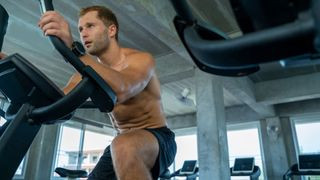Does Riding A Bike Build Your Glutes? Absolutely, but it’s not as straightforward as you might think, especially for us bikers who love hitting the open road. At usabikers.net, we’re diving deep into how you can maximize glute activation while enjoying your ride, ensuring you get the most out of every mile. By combining targeted stretches, glute-focused exercises, and adjustments to your riding posture, you can significantly enhance glute development while preventing muscle imbalances.
1. How Does Biking Engage Your Glutes?
Yes, riding a bike does engage your glutes, primarily the Gluteus Maximus, playing a role in hip extension during the pedal stroke. Studies using electromyography (EMG), which measures electrical activity in muscles, confirm glute activation while cycling. The Gluteus Maximus is most active from the top of the pedal stroke down to about three-quarters of the way through, helping to push the pedal down.
While your glutes are indeed involved, it’s worth noting that other muscles, like your quadriceps, hamstrings, and calves, also contribute significantly to the pedaling action. In fact, the Rectus Femoris, a part of your quadriceps, tends to be even more active than your Gluteus Maximus. For us at usabikers.net, understanding this balance is key to optimizing your workout. We need to ensure that our glutes are getting enough attention, even with the other muscles chiming in. This is where technique and targeted exercises come into play, helping you to get the most out of your glutes every time you ride.
2. What Does Science Say About Glute Activation During Cycling?
Science reveals that while the Gluteus Maximus is engaged during cycling, other muscles, particularly the Rectus Femoris, often dominate the effort. The Rectus Femoris functions as both a knee extensor and a hip flexor. The Glute Max straightens the hip, and the Rec Fem bends the hip.
According to the Law of Reciprocal Inhibition, when a muscle contracts, its antagonist muscle is inhibited. Since the Rectus Femoris is heavily involved in cycling, it can overshadow the Gluteus Maximus, potentially leading to less glute activation over time. Furthermore, the Gluteus Medius and Gluteus Minimus, responsible for hip abduction and rotation, are not significantly engaged during cycling due to the fixed foot position.
3. How Can Bikers Optimize Glute Activation During Rides?
To effectively build your glutes while biking, consider a comprehensive approach involving antagonist inhibition, glute activation, and targeted strengthening exercises.
3.1 Antagonist Inhibition
The Rec Fem can prevent the Glute Max from really getting worked, so the first step to take is to inhibit it, or prevent it from working quite so hard, to give your Glute Max more of a workout from cycling.
To prevent the Rectus Femoris from overpowering the glutes, incorporate targeted stretches to lengthen the Rec Fem, allowing the Gluteus Maximus to engage more effectively. Simple stretches held for 30-60 seconds daily can make a significant difference.
3.2 Activation
Muscle pre-activation has been shown to improve muscular contraction during exercise. We can use this to our advantage to get our glutes working during cycling.
Prior to cycling, perform glute activation exercises to prime the muscles for action. Simple exercises such as a Single Leg Hip Bridge or Banded Clam Shell can effectively activate the glutes, ensuring they contribute properly during your ride. Perform one to two sets of 15-20 reps per side before cycling to maximize glute engagement.
3.3 Strengthening
This will be performed separately from riding your bike, and the main goal of this is to develop strength in the glutes to prevent the Rec Fem from overpowering them and to make sure they can handle the extra work imposed on them when riding a bike.
Complement your cycling routine with targeted glute strengthening exercises performed separately. Exercises such as Hip Thrusts with a dumbbell or barbell, or Glute Kickbacks are highly effective for building glute strength and preventing the Rectus Femoris from dominating. Aim for two to three sets of eight to 15 reps one to two times per week to promote glute development.
 Woman Stretching Her Quadriceps
Woman Stretching Her Quadriceps
4. What Cycling Posture Maximizes Glute Engagement?
To maximize glute activation while cycling, adopting a bent-over posture can make a significant difference. Research from the Journal of Applied Biomechanics indicates that cycling with a forward lean engages the Gluteus Maximus more effectively than cycling upright or leaning back.
By positioning yourself with a slight bend at the hips, you encourage greater glute involvement throughout the pedal stroke. This posture promotes optimal muscle recruitment and helps prevent the quadriceps from dominating the movement. Remember to maintain a comfortable and sustainable position to avoid strain or discomfort during longer rides.
5. What Are the Best Glute Activation Exercises for Bikers?
Enhance your glute activation before hitting the road with these effective exercises, ensuring your glutes are primed and ready to work:
5.1 Single Leg Hip Bridge
This exercise targets the Gluteus Maximus and hamstrings, promoting hip extension and stability.
How to Perform:
- Lie on your back with knees bent and feet flat on the ground.
- Extend one leg straight out while keeping the other foot planted.
- Lift your hips off the ground, squeezing your glutes at the top.
- Lower your hips back down and repeat for 15-20 reps per side.
 Single Leg Hip Bridge Exercise
Single Leg Hip Bridge Exercise
5.2 Banded Clam Shell
This exercise targets the Gluteus Medius, promoting hip abduction and external rotation.
How to Perform:
- Lie on your side with knees bent and feet stacked, placing a resistance band around your thighs.
- Keeping your feet together, lift your top knee away from the bottom knee, squeezing your glutes.
- Lower your knee back down and repeat for 15-20 reps per side.
 Single Leg Hip Bridge Exercise
Single Leg Hip Bridge Exercise
5.3 Glute Kickbacks
This exercise isolates the Gluteus Maximus, promoting hip extension and muscle definition.
How to Perform:
- Start on your hands and knees, ensuring your back is flat and core engaged.
- Extend one leg straight back, squeezing your glutes at the top.
- Lower your leg back down and repeat for 15-20 reps per side.
 Woman Stretching Her Quadriceps
Woman Stretching Her Quadriceps
5.4 Hip Thrusts
This exercise is a powerhouse for glute development, targeting the Gluteus Maximus and hamstrings.
How to Perform:
- Sit with your back against a bench, knees bent, and feet flat on the ground.
- Place a barbell across your hips (optional for added resistance).
- Lift your hips off the ground, squeezing your glutes at the top.
- Lower your hips back down and repeat for 8-15 reps.
 Single Leg Hip Bridge Exercise
Single Leg Hip Bridge Exercise
6. What Are the Benefits of Strong Glutes for Bikers?
Strong glutes offer numerous benefits for bikers, enhancing performance, stability, and overall riding experience:
6.1 Enhanced Power and Performance
Strong glutes contribute to more efficient power transfer during the pedal stroke, resulting in increased speed and endurance.
6.2 Improved Stability and Control
Well-developed glutes stabilize the hips and pelvis, enhancing balance and control, particularly during challenging terrain or high-speed maneuvers.
6.3 Reduced Risk of Injury
Strong glutes support proper alignment and biomechanics, reducing the risk of knee, hip, and lower back injuries.
6.4 Enhanced Comfort
Strong glutes provide cushioning and support, minimizing discomfort and fatigue during long rides.
6.5 Aesthetic Benefits
Developed glutes contribute to a more athletic and toned physique, enhancing confidence both on and off the bike.
7. How Does Bike Setup Affect Glute Engagement?
Your bike setup can significantly impact glute engagement during rides. Optimizing your bike fit ensures proper muscle activation and reduces the risk of injury.
7.1 Saddle Height
Adjusting your saddle height allows for efficient leg extension and proper glute engagement. A saddle that is too low can limit glute activation, while one that is too high can cause excessive rocking and discomfort.
7.2 Handlebar Position
Adjusting your handlebar position influences your posture and weight distribution, affecting muscle recruitment. A lower handlebar position encourages a more bent-over posture, promoting greater glute activation.
7.3 Cleat Position
Adjusting your cleat position optimizes foot placement on the pedals, influencing muscle engagement and power transfer. Proper cleat alignment ensures efficient glute activation and reduces the risk of knee pain or discomfort.
7.4 Cadence
Cadence, or pedal stroke rate, affects muscle recruitment and fatigue levels. Maintaining a moderate cadence allows for efficient glute activation and reduces strain on the quadriceps and other leg muscles.
8. Can Indoor Cycling Classes Build Glutes?
Yes, indoor cycling classes can contribute to glute development, but it depends on the class structure and intensity.
8.1 Resistance
Adjusting the resistance on the bike increases the workload on the glutes, promoting muscle activation and growth.
8.2 Standing Climbs
Standing climbs engage the glutes more intensely, simulating uphill riding and maximizing muscle recruitment.
8.3 Interval Training
Incorporating interval training with high-intensity bursts and recovery periods challenges the glutes and promotes muscle adaptation.
8.4 Proper Form
Maintaining proper form and posture throughout the class ensures effective glute engagement and reduces the risk of injury.
9. What Are Common Mistakes to Avoid When Trying to Build Glutes with Cycling?
When trying to build glutes with cycling, avoid these common mistakes to maximize effectiveness and prevent injury:
9.1 Neglecting Proper Bike Fit
Riding with an improper bike fit can lead to inefficient muscle activation and increased risk of discomfort or injury.
9.2 Overreliance on Quadriceps
Focusing solely on pushing down with the quadriceps can limit glute engagement and lead to muscle imbalances.
9.3 Neglecting Glute Activation Exercises
Failing to activate the glutes before riding can result in suboptimal muscle recruitment and reduced effectiveness.
9.4 Ignoring Targeted Strengthening Exercises
Relying solely on cycling to build glutes may not provide sufficient stimulus for muscle growth and development.
9.5 Insufficient Resistance
Riding with minimal resistance may not challenge the glutes enough to stimulate muscle adaptation and growth.
10. What are the Best Types of Bikes for Glute Development?
Different types of bikes emphasize different muscle groups. For targeted glute development, consider these options:
| Bike Type | Description | Glute Emphasis |
|---|
FAQs:
How does biking work the glutes?
Biking works the Glutes byHip Extension (straightening the hips), and External Hip Rotation (rotating the thigh outwards).
Are there any specific exercises I can do to target my glutes for biking?
Yes, exercises like single-leg hip bridges, banded clamshells, and glute kickbacks can help activate and strengthen your glutes.
*Does changing my bike setup affect how my glutes

